Croissant Recipe (VIDEO)
There’s truly nothing like biting into a freshly baked French Croissant—crispy, flaky on the outside, and soft, airy layers inside. After years of practice and a life-changing trip to Paris, I’ve perfected this Croissant recipe. Watch the video tutorial to see how to make these delicate pastries from scratch.
![]() This post may contain affiliate links. Read my disclosure policy.
This post may contain affiliate links. Read my disclosure policy.
We love homemade French pastry recipes, from classic Eclairs to Cream Puffs, Raspberry Macarons, and beyond. Nothing compares to enjoying fresh home-baked goods, and this Croissant recipe is one you have to try. I even traveled to France to learn the secrets firsthand.
Croissant Video
Watch as I show you how to make homemade Croissants. Though their many layers might seem intimidating, I’ve discovered some key tricks that make the process much easier than it looks! So grab your rolling pin, and let’s get baking together!
Homemade Croissant RecipeFor years, I struggled with making homemade croissants and eventually gave up. While they always tasted good, no matter what I tried, they would pool butter at the bottom. Everything changed when I visited Paris and took a cooking course with a French chef at Lefoodist. Now, my croissants remind me of baked delights from the Parisian boulangeries we visited!
Before we start, know that this is not a quick process; it requires a bit of time, but not a ton of hands-on time. The dough needs time to rest between rolling and requires an overnight rest in the refrigerator before forming the croissants, but they are worth the wait.
![]() Ingredients for Croissants
Ingredients for CroissantsFlour – All-purpose flour provides the structure and base for the dough. Sugar – Adds a little sweetness and helps with the golden brown coloring. Salt – Enhances flavor and strengthens the dough. You’ll also need a pinch for the egg wash. European-Style Butter – Unsalted butter adds richness and helps create flaky layers. The butter layer, introduced during the lamination steps, is crucial for developing the pastry’s signature flaky texture. Instant Yeast – use a quick-rise or instant yeast to make the dough rise. Cold Water – Hydrates the dough and activates the yeast. Cold Milk – Adds flavor and makes the dough softer. Egg – Use a whole egg plus one extra egg yolk to brush onto your shaped croissants before baking. This provides a rich, golden-brown color and a glossy finish to the pastry when baked. Use the Correct Butter!My biggest takeaway from the French Chef was using European-style butter (I used Kerrygold brand). It has a higher fat content (85%) with less moisture and is more pliable, making it the key to better lamination in the dough and preventing a pool of butter at the bottom of your croissants. P.S. This higher-quality butter will also make your croissants taste better.
![]() How to Make Croissant DoughThe key to making great croissants is mastering the lamination process to achieve those signature thin layers of dough and butter that puff up beautifully when baked. I’ve broken this recipe down into manageable steps for you so you will nail it on your first try.
How to Make Croissant DoughThe key to making great croissants is mastering the lamination process to achieve those signature thin layers of dough and butter that puff up beautifully when baked. I’ve broken this recipe down into manageable steps for you so you will nail it on your first try.
Make the Dough – In the bowl of a stand mixer, combine the flour, sugar, salt, and yeast, and whisk together. Add the water, milk, and softened butter. With the dough hook attachment, mix on speed 2 for 3-4 min, or until a smooth ball of dough forms. Cover the bowl with plastic wrap and let it rise in a warm place (75-90°F) until nearly doubled in size, about 1 1/2 to 2 hours, depending on room temperature. Cover a cutting board with plastic wrap and tip the risen dough over the covered board. Massage it into a 10 1/2-inch square, then cover with plastic wrap and refrigerate for 1-2 hours.![]()
Pound the Butter – Cut the butter lengthwise into 1/2-inch thick slabs. Arrange the slabs on a sheet of parchment paper to form a 5-inch square. Cover with another piece of parchment or wax paper and use a rolling pin to pound the butter into a 7 1/2-inch square, trimming and rearranging the butter as needed to achieve the correct size. Refrigerate until fully chilled.![]() How to Laminate the DoughLaminating dough is the process of repeatedly folding butter into the dough to create dozens of layers in your homemade croissants. When baked, the butter melts and turns into steam, causing the dough layers to puff up and form delightful air pockets. This process gives croissants their irresistible crispy exterior and soft, tender interior!
How to Laminate the DoughLaminating dough is the process of repeatedly folding butter into the dough to create dozens of layers in your homemade croissants. When baked, the butter melts and turns into steam, causing the dough layers to puff up and form delightful air pockets. This process gives croissants their irresistible crispy exterior and soft, tender interior!
Important Tip: During this process, you want to keep the dough and butter cool so that the butter stays firm. If you find your dough getting too soft, pop it into the refrigerator for 15 minutes to cool it down.
Encase the Butter – Combining the dough and butter starts the lamination process. Set the butter at an angle over the dough so the corners of the butter are in the center of the sides of the dough (the butter should sit in a diamond shape). Fold the dough over the butter, stretching it slightly if needed to reach the center. Press the edges of the dough together to fully encase the butter inside, ensuring it doesn’t escape.![]()
Turn 1 – Place the dough on a floured work surface. Lightly flour the top of the dough and use a rolling pin to press down over the dough, elongating it (this helps to distribute the butter evenly). Then, start rolling it out to a rectangle measuring 8 by 24 inches, keeping the edges straight. Press in the corners with your hands if it loses its shape. Fold the dough into thirds, brushing off any excess flour. You should have a rectangular shape. Freeze for 20 minutes or refrigerate for 1 hour (set your timer).![]()
Turn 2 – Repeat the rolling and folding process, this time rolling in the direction of the two open ends until the dough measures 8 by 24 inches. Fold into thirds again, brushing off excess flour. Cover and freeze for 20 minutes or refrigerate for 1 hour. (You can refrigerate overnight at this point if needed.) Turn 3 – Repeat the rolling to 8 by 24 inches and fold into thirds. Place the dough on a baking sheet, cover it completely with plastic wrap, tucking it under the dough. Refrigerate overnight or up to 2 days (or freeze at this point). The dough will look puffed after refrigeration.![]() How to Form Croissants
How to Form Croissants Roll the Dough for Croissants – Remove the dough from the refrigerator and place it on a floured counter, lightly flouring the top. Press along the length of the dough with the rolling pin to widen it and wake it up. Then, roll the dough into a long and narrow strip measuring 8 inches wide by 44 inches long. Sprinkle more flour if the dough sticks. Lift the dough at the midpoint and allow it to shrink back from both sides to prevent shrinking when cutting. Trim the dough ends so it is 40 inches long.![]()
Cut Croissants – Place a yardstick or tape measure across the top of the dough and use a knife to mark the top at 5-inch intervals (there will be 7 marks). Move the yardstick to the bottom of the dough and mark 2 1/2 inches from the end, then make marks at 5-inch intervals from that point along the bottom (for a total of 8 marks), falling halfway between the marks at the top. Set a clean ruler from the top corner to the first bottom mark and cut with a pizza cutter to form the first triangle. Repeat cutting the rest of the triangles. You’ll end up with 15 triangles and a few scraps of dough.![]()
Shape Croissants – Use a knife to cut a 1/2-inch slit at the bottom of each triangle. Give the triangles a little tug to expand them to about 10 inches in length, then tightly roll the dough into a croissant. Transfer to two parchment-lined rimmed baking sheets, keeping them evenly spaced. Repeat with the remaining triangles. I also roll up the scraps into mini-croissants that may not look as nice but taste delicious.![]() How to Bake Croissants
How to Bake Croissants Make the Egg Wash and Proof – In a small bowl, combine 1 egg, 1 yolk, and a pinch of salt, and beat together with a fork. Brush the egg wash over the croissants. Cover and refrigerate the remaining egg wash. Let the croissants rise uncovered at room temperature (70-75°F) for about 1-2 hours, depending on the room temperature, or until they have noticeably increased in size (but not doubled).![]()
Bake Croissants – Brush the croissants again with the remaining egg wash, ensuring to cover the tops and sides. Bake at 425°F for 10 minutes (in a conventional oven on the top and bottom thirds). Rotate the pans and bake for another 8-10 minutes until they are a deep golden brown.![]() How Do You Know When Croissants Are Proofed?The proofing stage is important to ensure the best rise in the oven. Avoid proofing in a warm place, as this can cause the butter to melt out. Here’s how to tell when croissants are ready to bake:
How Do You Know When Croissants Are Proofed?The proofing stage is important to ensure the best rise in the oven. Avoid proofing in a warm place, as this can cause the butter to melt out. Here’s how to tell when croissants are ready to bake:
Puffed – Croissants should look larger but not quite doubled in size. Visible Layers – You should be able to see defined layers on the side. Wiggle – When you shake the sheets, the croissants will wiggle. Soft – When you poke the tops, they will feel soft like marshmallows. Can I Prepare the Dough Ahead of Time?This recipe takes time, but it doesn’t have to control you. You can easily adjust the timing of your croissant dough by sticking it in the fridge at various stages to fit your schedule. For instance, you can refrigerate the dough overnight after Turn 2, or store it for up to 2 days after Turn 3.
You can also freeze the dough after Turn 3 and then thaw it overnight in the refrigerator when you’re ready to create your delicious croissants. This flexibility makes it convenient to enjoy freshly baked croissants when you need them.
![]() How to Serve Croissants Here are some scrumptious ideas for serving your croissants for breakfast, lunch, or dinner:
How to Serve Croissants Here are some scrumptious ideas for serving your croissants for breakfast, lunch, or dinner:
Sweet: use leftover or stale croissants to make Almond Croissants or French Toast. I have a yummy Croissant French Toast recipe in my Cookbook. Savory: Make mini sandwiches that are perfect to serve at a party. Caprese style with fresh mozzarella, tomato, basil, and Balsamic Glaze; stuffed with smoked salmon and cream cheese, Chicken Salad, deli meats such as ham or turkey and cheeses, or all of the fixings for delicious Breakfast Sandwiches. Simple: Serve warm with whipped Honey Butter or jam on top and you’ll be set. Storing Croissants Freezing: Once the croissants have cooled to room temperature, transfer them to a freezer-safe bag, removing any excess air to prevent freezer burn. You can freeze them for up to three months. Thaw at room temperature for 1-2 hours. To Reheat: I highly recommend refreshing leftover or thawed croissants in the oven or air fryer. Set your air fryer to 300°F. Brush the tops of your croissants with melted butter, if desired, for extra flavor and moisture. Heat for 3-5 minutes until warm and slightly crispy. Set your oven to 350°F and heat croissants on a baking sheet for 5-10 minutes or until warm. ![]() Don’t let the thought of making croissants intimidate you. You’ll be rewarded with delicious, flaky pastries that will impress your friends and family.
Don’t let the thought of making croissants intimidate you. You’ll be rewarded with delicious, flaky pastries that will impress your friends and family.
More Homemade Pastry RecipesIf you love the delightful taste of homemade croissants, then you won’t want to miss these irresistible pastry recipes, especially the French Pastries!
Blueberry Scones Fruit Tart (with Pate Sucree crust) Easy Apple Turnovers Baklava Churros Cream Cheese DanishesHUNGRY FOR MORE? Subscribe to Natasha’s Newsletter and YouTube for meal-time inspiration and let’s connect on social! Follow us on Facebook, Instagram, Pinterest, and X for a peek behind the scenes of Natasha’s Kitchen.
 This post may contain affiliate links. Read my disclosure policy.
This post may contain affiliate links. Read my disclosure policy.We love homemade French pastry recipes, from classic Eclairs to Cream Puffs, Raspberry Macarons, and beyond. Nothing compares to enjoying fresh home-baked goods, and this Croissant recipe is one you have to try. I even traveled to France to learn the secrets firsthand.
Croissant Video
Watch as I show you how to make homemade Croissants. Though their many layers might seem intimidating, I’ve discovered some key tricks that make the process much easier than it looks! So grab your rolling pin, and let’s get baking together!
Homemade Croissant RecipeFor years, I struggled with making homemade croissants and eventually gave up. While they always tasted good, no matter what I tried, they would pool butter at the bottom. Everything changed when I visited Paris and took a cooking course with a French chef at Lefoodist. Now, my croissants remind me of baked delights from the Parisian boulangeries we visited!
Before we start, know that this is not a quick process; it requires a bit of time, but not a ton of hands-on time. The dough needs time to rest between rolling and requires an overnight rest in the refrigerator before forming the croissants, but they are worth the wait.
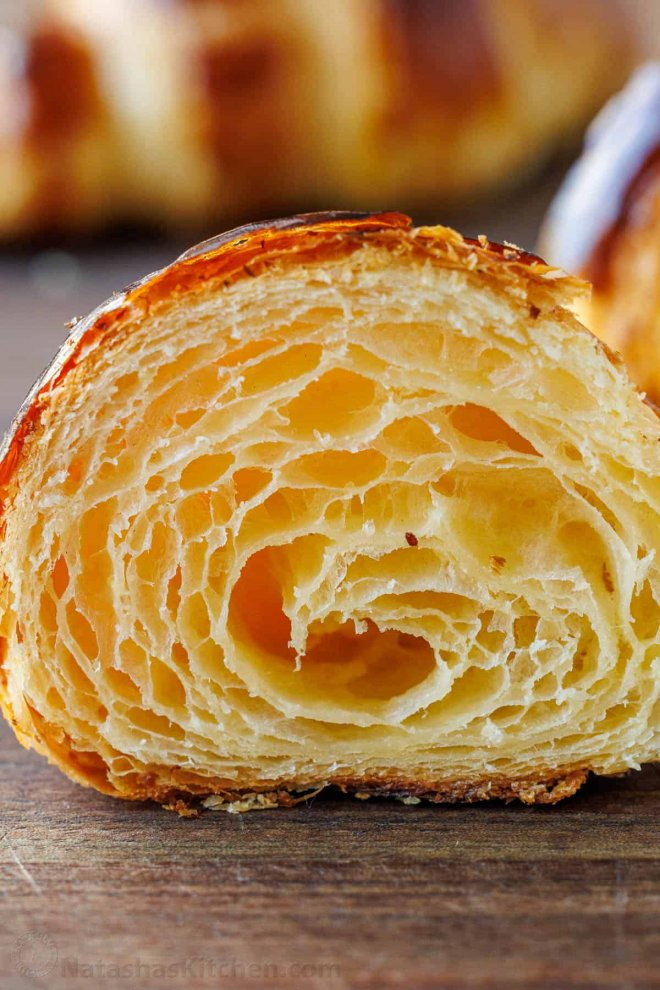 Ingredients for Croissants
Ingredients for Croissants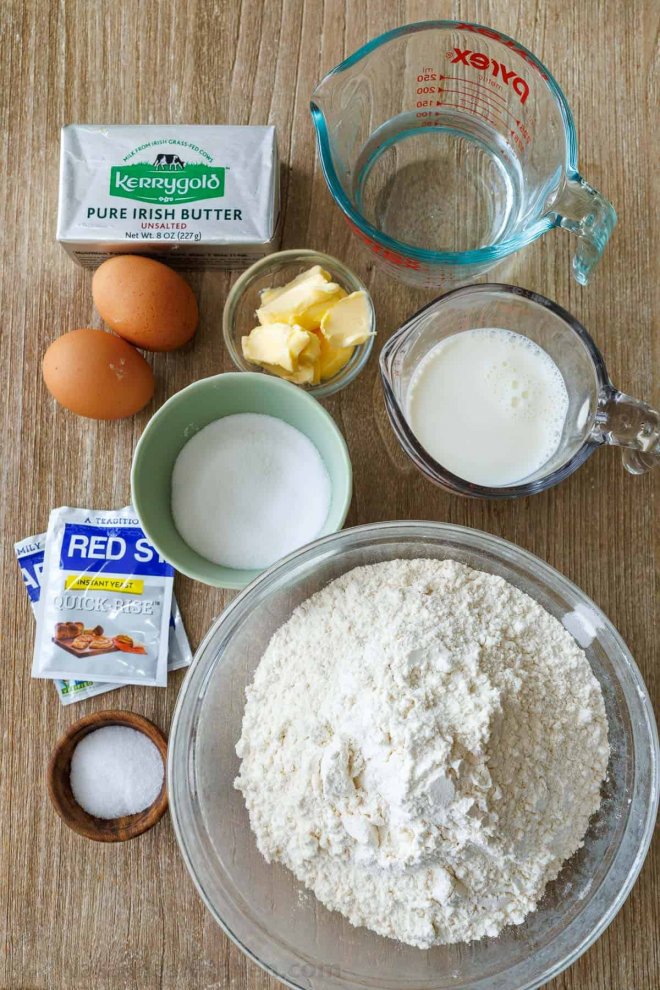 How to Make Croissant DoughThe key to making great croissants is mastering the lamination process to achieve those signature thin layers of dough and butter that puff up beautifully when baked. I’ve broken this recipe down into manageable steps for you so you will nail it on your first try.
How to Make Croissant DoughThe key to making great croissants is mastering the lamination process to achieve those signature thin layers of dough and butter that puff up beautifully when baked. I’ve broken this recipe down into manageable steps for you so you will nail it on your first try.
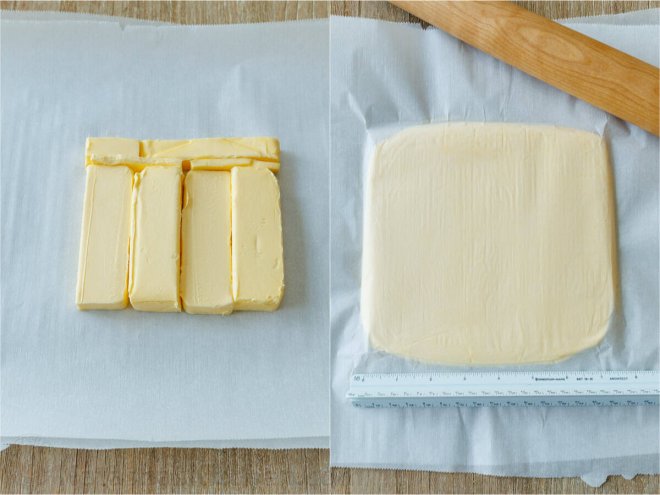 How to Laminate the DoughLaminating dough is the process of repeatedly folding butter into the dough to create dozens of layers in your homemade croissants. When baked, the butter melts and turns into steam, causing the dough layers to puff up and form delightful air pockets. This process gives croissants their irresistible crispy exterior and soft, tender interior!
How to Laminate the DoughLaminating dough is the process of repeatedly folding butter into the dough to create dozens of layers in your homemade croissants. When baked, the butter melts and turns into steam, causing the dough layers to puff up and form delightful air pockets. This process gives croissants their irresistible crispy exterior and soft, tender interior!Important Tip: During this process, you want to keep the dough and butter cool so that the butter stays firm. If you find your dough getting too soft, pop it into the refrigerator for 15 minutes to cool it down.
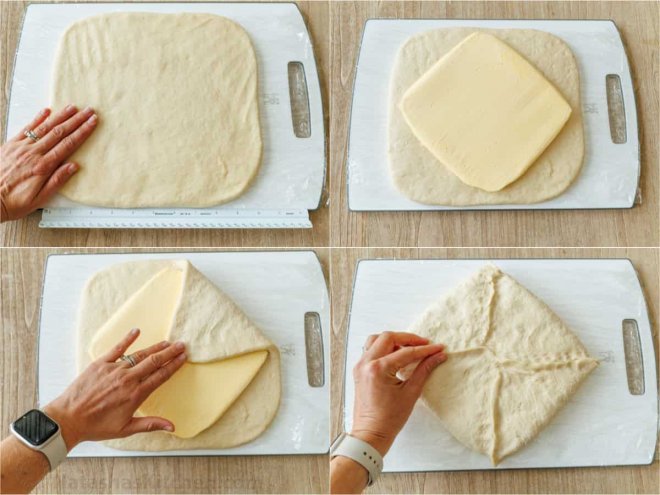
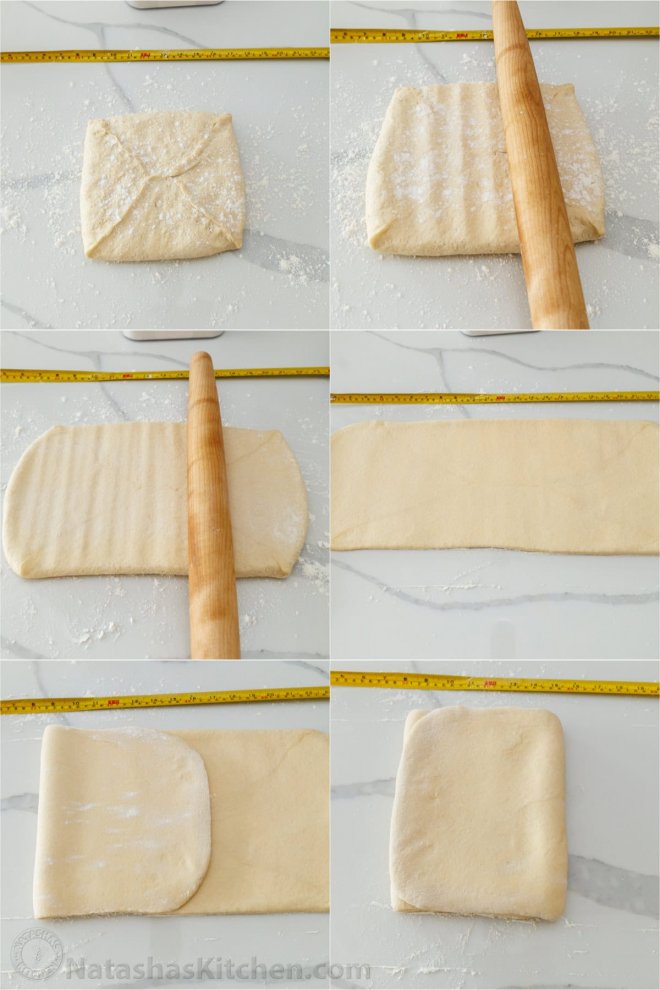
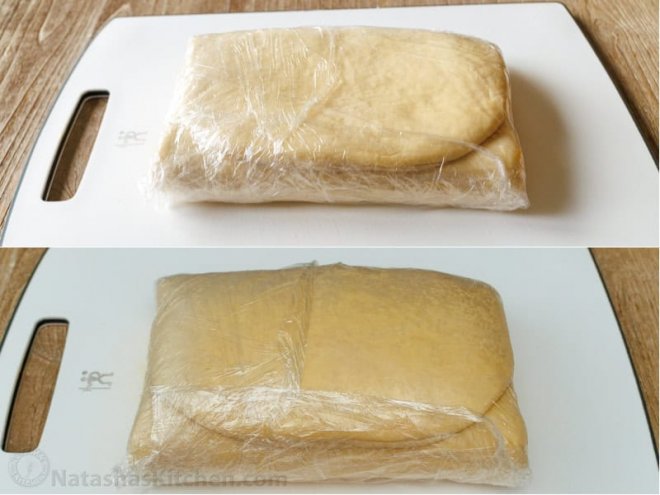 How to Form Croissants
How to Form Croissants
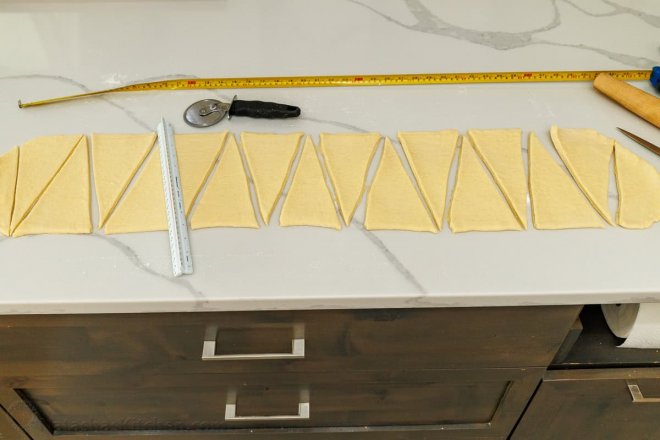
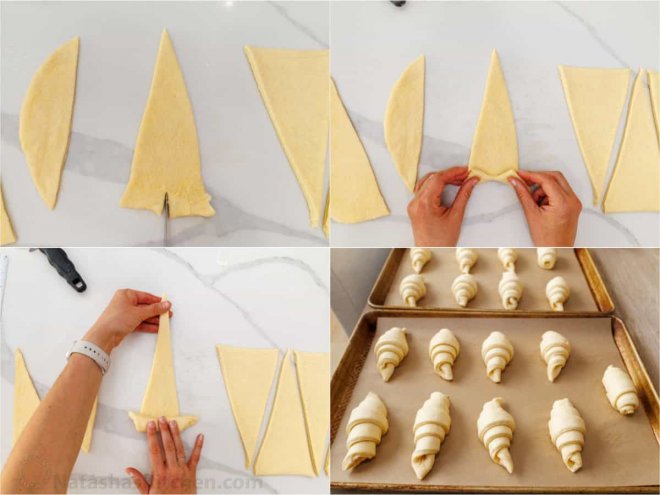 How to Bake Croissants
How to Bake Croissants
 How Do You Know When Croissants Are Proofed?The proofing stage is important to ensure the best rise in the oven. Avoid proofing in a warm place, as this can cause the butter to melt out. Here’s how to tell when croissants are ready to bake:
How Do You Know When Croissants Are Proofed?The proofing stage is important to ensure the best rise in the oven. Avoid proofing in a warm place, as this can cause the butter to melt out. Here’s how to tell when croissants are ready to bake: You can also freeze the dough after Turn 3 and then thaw it overnight in the refrigerator when you’re ready to create your delicious croissants. This flexibility makes it convenient to enjoy freshly baked croissants when you need them.
 How to Serve Croissants Here are some scrumptious ideas for serving your croissants for breakfast, lunch, or dinner:
How to Serve Croissants Here are some scrumptious ideas for serving your croissants for breakfast, lunch, or dinner: Don’t let the thought of making croissants intimidate you. You’ll be rewarded with delicious, flaky pastries that will impress your friends and family.
Don’t let the thought of making croissants intimidate you. You’ll be rewarded with delicious, flaky pastries that will impress your friends and family.More Homemade Pastry RecipesIf you love the delightful taste of homemade croissants, then you won’t want to miss these irresistible pastry recipes, especially the French Pastries!











